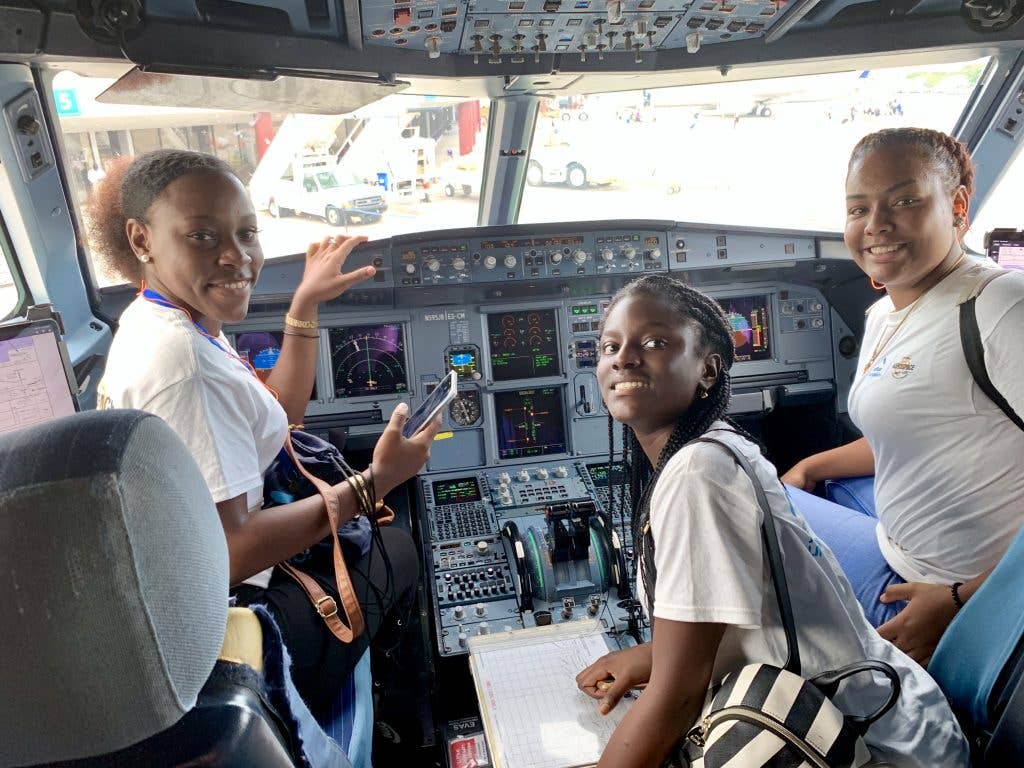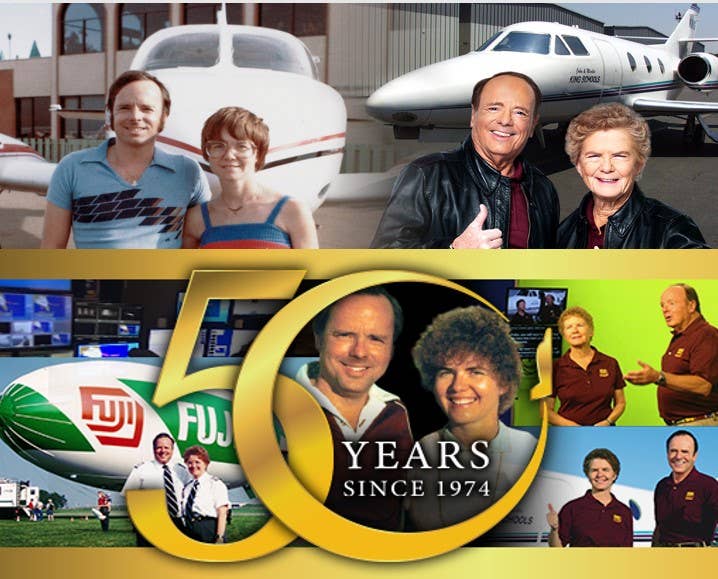Outreach Programs Doing Their Part to Combat the Pilot Shortage
Minorities, women, and young people are of particular focus to many groups.

The Organization of Black Aerospace Professionals says its Project Aerospace reaches more than 100,000 youth and young adults each year. [Courtesy: OBAP]
Editor’s note: This article is the fourth in a six-part series examining the aviation industry’s pilot shortage and what can be done about it.
Jan. 14: An overview of the issue | Jan. 17: How the military is dealing with its shortage | Jan. 18: Recruiting right from the flight schools | Jan. 19: Outreach programs doing their part | Jan 20: The role of flight schools in creating pilots | Jan 21: Want to get your chops back? Here’s how.
At the entry level, many aviation industry stakeholders have recognized the need to reach out to students at an early age to nurture a pipeline of talent—as one way to deal with the recent shortage of pilots.
In some cases, it’s strategic for groups to target underrepresented groups so that they can improve their presence in the industry. In others, the focus comes from a business-segment level.
Organizations like OBAP give minority pilots a voice.
In 1976, a group of 38 African American pilots and industry contributors gathered at the O’Hare Hilton hotel in Chicago to put together a plan to address the industry’s lack of diversity. The men represented close to half of all the Black pilots who existed in the aviation industry in the U.S. at that time.
At the end of the meeting, what's now known as the Organization of Black Aerospace Professionals—OBAP—was formed. Now, nearly 50 years later, this nonprofit organization can point to a measurable track record of encouraging especially Black Americans to take their place in the industry.
OBAP’s Project Aerospace offers annual opportunities to inform and prepare aspiring aerospace professionals for their future careers. Designed to meet the career roadmap trajectory, this includes initial exposure to the industry through in-school career day events, immersive summer programs, flight training academies, and professional development opportunities held nationwide.
OBAP says Project Aerospace reaches more than 100,000 youth and young adults each year.
To date, OBAP has awarded $5.8 million in scholarships to more than 470 diverse recipients nationwide. In 2021 alone, OBAP awarded more than 50 pilots and aerospace professionals’ scholarship funding totaling more than $1 million.
Is it working? Somewhat. According to 2020 data from the U.S. Bureau of Labor Statistics, about 3.4 percent of the country’s 155,000 pilots and flight engineers were Black, with just over 10 percent of pilots and engineers listed as Black, Latino (5 percent), or Asian (2.2 percent). Black women are less than 1 percent of female airline pilots, which means you could gather the approximately 150 black women from the flight decks and fit them all on a Boeing 737 Max with some room to spare.
But there has been a bit of progress. The report from 2012 shows just 2.7 percent of the airline pilot population at that time was Black. The needle is moving—slowly.
Halle Green, a first officer for a U.S. regional carrier, is a part of that 1 percent of Black female airline pilots. She’s been a volunteer for OBAP for many years, participating in a range of programs including their APIS program, ACE Academy, and other community efforts. She shared with FLYING that she joined OBAP as a pilot mentor to “help mold and mentor our next generation to occupations I didn’t know existed.”
Green says she is fulfilled “watching the excitement grow in the students and being able to be present as they gain exposure to different possibilities for their future.”
This Denver-based pilot says she uses her spare time to volunteer at the OBAP ACE Denver Academy.
Airline Pipeline Programs
Recent numbers have suggested to those airlines running pilot programs to be intentional about attracting underrepresented groups. In June 2021, United Airlines announced that it wanted half of its 5,000 new pilots recruits over the next decade to be women and people of color. The airline plans to fulfil this through its United AVIATE program. It also plans to distribute as much as $2.4 million (half coming from JP Morgan Chase) to groups like OBAP, plus the Latino Pilots Association, Professional Asian Pilots Association, and Sisters of the Skies.
Indeed, many other airlines are finding ways to develop long-term relations with prospective pilots. American Airlines has its Cadet Academy, Delta Air Lines has Propel, Southwest Airlines has Destination 225°, but perhaps the most targeted is Frontier Airlines’ program that has begun hiring directly from college flight departments.
The typical format for these programs is to partner with a university with a Part 141 training program and a series of regional carriers, Part 91 or 135 operators, or cargo carriers, before the candidates could have an opportunity to interview or flow into their workforces.
Elsewhere, airlines have for a long time performed outreach in local communities through programs such as Southwest’s “Adopt-A-Pilot,” which began in 1997 and prominently features the airline’s pilots wearing colorful ties designed by students across the country.
These programs have such enduring traits that the airline, amid the disruption to in-person classes at the height of the pandemic, embraced the opportunity to deliver lessons virtually.
Women in Aviation International
Perhaps one of the most cogent outreach programs is the Women in Aviation International (WAI) Girls in Aviation Day, typically hosted the last Saturday in September each year. By leveraging its vast local chapters network—148 in 60 countries—it works with contributing corporate members to deliver an engaging aviation experience for girls ages 8 through 17.
When the in-person events were canceled in 2020, WAI leveraged its Aviation for Girls app, which allowed girls in 60 countries to participate in content year-round. The success of the app led the group to deliver a hybrid approach in 2021, doing both virtual and in-person events.
“Girls in Aviation Day has been instrumental in introducing girls all over the world to opportunities in aviation and STEM that they never would have considered,” outreach director Molly Martin said in a release. “We work very hard to bring participants and role models together so girls can see themselves in those exciting roles.”
WAI hopes this will nurture young women to make the transition to their larger organization, which has more than 12,000 active members. The goal of the 30-year-old nonprofit association is to encourage and advance women in all aviation career fields and interests.
Much of the organization’s work leads up to its WAI conference each March, where it features, celebrates, and awards prominent women—and proponents of women—in the field. The organization says it’s given out more than $14.5 million in scholarships since 1995. In 2021, it awarded 149 scholarships valued at more than $730,000.
Moriah Graham was a 2020 scholarship recipient and a beneficiary of a United Airlines Pilot scholarship.
“The financial support I have received during my flight training has been an integral part in my overall success,” Graham told FLYING. “This scholarship afforded me the opportunity to finish my multiengine training at Embry-Riddle and gave me the mentorship and support I needed to finish my last courses.”
Graham’s journey is littered with supportive outreach efforts and scholarships that help her take the next steps in her training. She spoke of that support, which led to her become Delaware’s youngest African American female pilot.
“I was blessed to have been selected in high school to participate in a program that paid for my private pilot’s certificate and train on Dover Air Force Base,” she said. “Had it not been for this program, I would have never considered piloting as a career option.”
She also earned scholarships from Southwest Airlines (through OBAP) which she called “life-changing,” and was selected as a cadet for PSA Airline’s pipeline program.
Still Work to Be Done for Women Pilots
Outreach efforts and scholarships like these support WAI’s mission, but a 2021 report by Rebecca Lutte, associate professor at the University of Nebraska’s Aviation Institute, paints a grim picture. Lutte argues that “a primary concern is the lack of significant change in the representation of women in aviation over time,” calling the trend “a flatline effect.”
She cites many reasons why more women pilots aren’t entering the workforce, such as challenging work-life balance, harassment, or corporate structures that fail to account for working mothers.
“Over a span of 60 years, the percentage of women commercial pilots has changed at a rate of about 1 percent a decade and mechanics have increased at about half that rate.
“Examining annual data reveals that over the last 15 years women in aviation have experienced inconsequential growth in areas such as private pilots (.7 percent), commercial pilots (1.4 percent), airline transport pilots (1.1 percent), certified flight instructors (CFIs) (.6 percent), air traffic controllers (1.3 percent) and maintenance technicians (.7 percent).
“This is particularly concerning given that commercial pilots and CFIs are the pipelines to the professional pilot workforce. Additionally, it should be noted that women student pilots (14 percent) are not converting at high rates to private pilots (7 percent),” Lutte says in her study.
Indeed, this has created a harsh reality. As Lutte further points out in her study using 2021 data from the Air Line Pilot Association (ALPA), of the 55,804 airline pilots in the US, only 3,196 are women. Moreover, of the 24,897 captains, only 888 are female captains. They could all fit on an Airbus A380.
Business Aviation's Part
It seems the entire industry is aware of the hard-to-grasp workforce. In business aviation, the National Business Aviation Association (NBAA) has tried many things. An indicator that this was a priority came during a 2018 Business Aviation Management Committee (BAMC) workforce summit, where the attendees discussed educational outreach and workforce development strategies, highlighting the diversity of job opportunities available to young professionals.
“This is not just a public relations thing for the company, it’s all hands on deck,” said James Brough, national aviation and space education program manager for the FAA. He continued: “Go out of your comfort zone, go talk to the schools.”
One attendee, Lee Blake, a chief pilot at Cummins Inc., pointed out that the department had to look beyond only trying to match compensation in trying to compete with the airline, but rather to look at the big picture quality of life and pilot experience, which turned out to be a prescient hunch before the pandemic.
Elsewhere, the organization has encouraged its nearly 70 regional groups and their burgeoning Young Professional (YoPros) contingents across the country to connect with their local communities. Regional groups host a myriad of events throughout the year for their members, from meet-and-greets to happy hours. Moreover, a 2019 article by the NBAA makes the case that corporate departments need to be intentional about scholarship programs.
Jay Orwin, the president of the Michigan Business Aviation Association (MBAA) in the article shared that, “Several of our members can count nearly half of their active pilots as former scholarship participants.”
These are some of the prominent programs that have focused on recruiting pilots through a variety of ways for a long time, and there are many other grassroots outreach efforts that exist. In many ways, they are making progress, but will it be enough to meet the demand that lies ahead?

Subscribe to Our Newsletter
Get the latest FLYING stories delivered directly to your inbox






